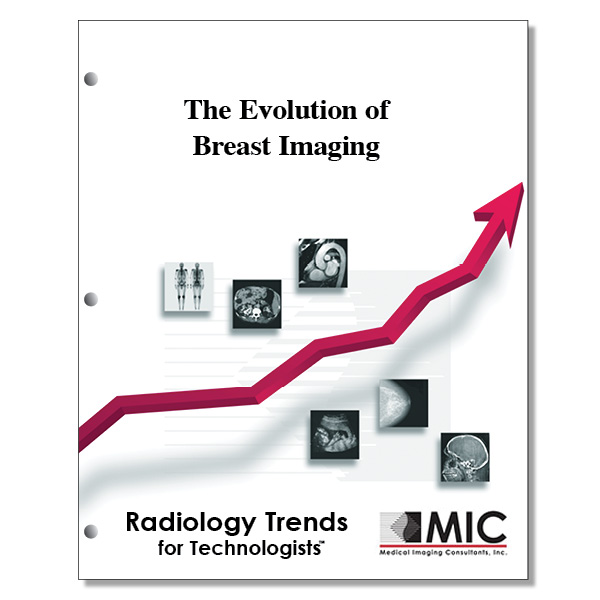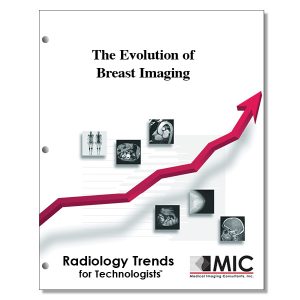

The Evolution of Breast Imaging
A review of the evolution of breast imaging starting from a historical perspective and progressing to the present day.
Course ID: Q00427 Category: Radiology Trends for Technologists Modalities: Mammography, MRI, Sonography2.75 |
Satisfaction Guarantee |
$29.00
- Targeted CE
- Outline
- Objectives
Targeted CE per ARRT’s Discipline, Category, and Subcategory classification for enrollments starting after February 24, 2023:
[Note: Discipline-specific Targeted CE credits may be less than the total Category A credits approved for this course.]
Breast Sonography: 0.50
Patient Care: 0.50
Patient Interactions and Management: 0.50
Mammography: 0.50
Procedures: 0.50
Mammographic Positioning, Special Needs, and Imaging Procedures: 0.50
Magnetic Resonance Imaging: 0.25
Procedures: 0.25
Body: 0.25
Sonography: 0.25
Procedures: 0.25
Superficial Structures and Other Sonographic Procedures: 0.25
Outline
- Introduction
- Evolution of Breast Imaging Technique
- Direct Exposure Mammography
- Xeromammography
- Screen-Film Mammography
- Advent of Screening Mammography
- The Oblique View and Specialized Mammographic Views
- Standardized Reporting and Outcomes
- Breast Density Legislation
- Digital Mammography
- Thermography
- Complementary Breast Imaging Technologies
- Breast US
- Breast MR Imaging
- Breast Intervention
- Freehand Localization
- Grid Localization
- Percutaneous Breast Biopsy for Nonpalpable Lesions
- Fine-Needle Aspiration Biopsy
- Core Biopsy
- A Look to the Future
- Digital Breast Tomosynthesis
- Breast MR Spectroscopy and Diffusion
- Abbreviated Breast MR Screening
- Alternative Imaging Modalities
- Conclusion
Objectives
Upon completion of this course, students will:
- understand options for diagnosing breast cancer prior to breast imaging becoming available to patients
- recall physicians associated with early breast imaging techniques
- differentiate between x-ray equipment used for breast roentgenograms in the early 1920s and 1930s
- describe Egan’s mammography positioning techniques
- explain imaging challenges associated with underexposed breast images
- specify the origin of the xeromammography process
- name the inherent parameters associated with the xeroradiographic process
- list challenges associated with the xeroradiographic process
- list advantages of breast compression
- know the year in which the oblique mammographic view was introduced
- specify the benefits of two-view mammographic screening
- describe the best mammographic view for visualizing lesions in the augmented breast
- state the benefits of magnification mammography
- understand the factors necessary for successful mammography
- name the first structured reporting language for imaging
- list the components of the BI-RADS reporting system
- specify imaging modalities that use the BI-RADS standardized auditing approach
- list challenges associated with digital mammographic imaging
- articulate advantages to converting to digital mammography
- express the number of facilities and units in the United States using full-field digital mammography
- understand the benefits of ultrasound coupled with mammography for evaluating breast masses
- list barriers to widespread adoption of ultrasound as a breast screening tool
- name early successes with diagnostic applications of breast MR
- differentiate between diagnostic and screening breast MR imaging
- state the most sensitive modality for breast imaging
- name the first physician to perform freehand breast needle localization
- describe breast needle placement in order to reduce chance of pneumothorax
- list the modalities with which wire localization can be performed
- note both patient and society benefits of image-guided percutaneous breast biopsy
- understand the role of image-guided percutaneous biopsy as is relates to tissue diagnosis
- explain when and where fine-needle aspiration was first performed
- list the advantages of core biopsy over fine-needle aspiration
- discuss data in regard to digital breast tomosynthesis
- define MR spectroscopy
- understand the potential applications of diffusion-weighted imaging
